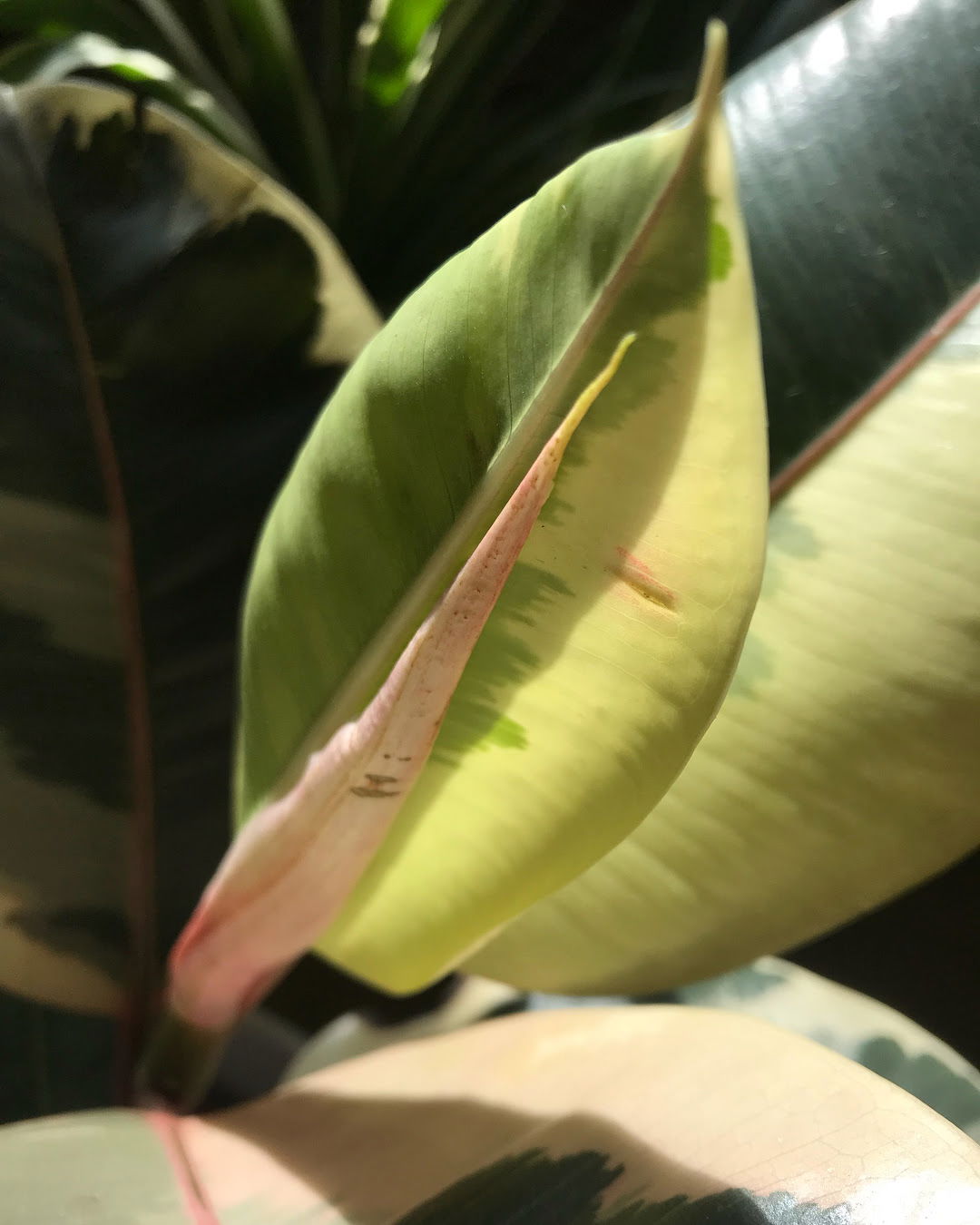
Ficus elastica 'Variegata'
Listen to the Rubber Plant Podcast Here!
Contents
- Top Tips
- Location, Water, Humidity & Fertilisation
- Common Issues
- Origins, Temperature, Propagation, Repotting & Toxicity
Need the answer to a specific plant query? Book a 1-to-1 video call with THE HOUSEPLANT DOCTOR™, the website's friendly author, to overcome and address your niggling problem! Available on iMessage, WhatsApp, Facebook Messenger & more.
Top Tips & Info
- Care Difficulty - Easy to Moderate
- Bright, indirect light is critical for quality growth; locations that are too dark will increase the severity of over-watering. We'd recommend keeping your plant in a windowsill that offers delicate exposure of either morning or evening sunlight for ultimate health and growth.
- Allow half of the soil to dry out in between waters, reducing this further in the autumn and winter months.
- Although average room humidity is acceptable, if you live in an excessively dry environment (below 40%), it's advised to introduce a pebble tray to counteract browning leaf-tips.
- Fertilise using a 'Houseplant' labelled feed every four waters in the spring and summer, reducing this to every six in the colder months.
- Repot every three years using a 'Houseplant' labelled compost; be sure to respect the roots as transplant shock is a big issue that could result in wilting or even death.
- Keep an eye out for Spider Mites that'll locate themselves along the ridges of the under-leaves.
Location & Light - 🔸🔸
Similarly to most other houseplants, 'bright, indirect light' is great for quality growth. Specimens placed in darker locations will lose their patterns (if variegated), along with the increased chance of root rot and stalled growth. Alternatively, a setting that offers too much sun will scorch the leaves, de-hydrate the foliage, and will leave your plant with a washed-out appearance. If it were up to us, we'd recommend a bright location with a few hours of morning or evening sunlight to aid better growth and downplay the chance of over-watering. It's also crucial to present an environment that lacks sudden fluctuations of temperature or humidity, as both may result in sudden lower leaf loss.
Water - 🔸🔸
Less is more with Rubber Plants, so only rehydrate the soil once the top half dries out, feeling the pot's weight for confirmation. Reduce this further in the colder months to replicate its dormancy period and to downplay the risk of over-watering in winter (common). Under-watering symptoms include stunted or deformed growth, yellowing leaves and crispy foliage; these issues are more familiar with forgetfulness or too much sunlight/heat. Over-watering symptoms include yellowed older leaves that turn into leaf loss, stunted growth or even stem collapse. If a specimen is displaying any of these signs, you could be looking at a case of root rot - click here to learn more about addressing this issue.
Humidity - 🔸🔸
This species thrives in a stable, humid environment, meaning that a pebble tray (or frequent misting) is mandatory for success. Signs of an under-humid room are primarily similar to inconsistent fluctuations, with slowed growth, browning leaf-tips and leaf loss being the common symptoms.
Fertilisation - 🔸🔸
Feed every four waters during the growing period and every six in the autumn and winter, using a 'Houseplant' labelled fertiliser. Never apply a 'Ready to Use’ product into the soil without a pre-water first, as it may burn the roots and lead to yellowed leaves.
Common Issues with Rubber Plants
The yellow spots that form along the outer edges of the leaves are called cystoliths; they are entirely harmless to your Ficus and will form once the leaf hardens & matures.
Lower leaf loss is a common and significant issue among gardeners. This unfortunate phenomenon could be a product of several different problems, most notably being dark locations, water-related abuse or environmental shock. Introduce the plant to a more well-lit area with a splash of off-peak sunlight; if caught in time, the leaf loss should stop within a week. If you feel that you're watering habits aren't up to scratch, familiarise yourself with our care tips provided at the top of this article. It's always best to under-water a Ficus than over-do it, purely on its poor ability to endure continued sogginess. The final culprit could be down to a sudden relocation; if you've recently purchased the specimen, the chances are it is still acclimatising to the new environment. Although this shouldn't happen, a vastly different setting will cause sudden foliage loss and stunted growth. You'll have two options of either waiting it out or presenting a more Ficus-friendly environment, mentioned in the 'Location & Light' section. If you'd like to speak to ukhouseplants regarding this issue, don't be afraid to book a 1-to-1 call with THE HOUSEPLANT DOCTOR™ to help guide you through the step-by-step process!
Ideally, variegated (multicoloured) plants shouldn't be kept in a darker area due to the risk of lower rates of photosynthesis. Although this may sound harmless, prolonged low rates will gradually result in weakened health, as the plant won't convert enough light into storable energy. Common symptoms of this include stunted growth, lower leaf loss and a lack of variegation on its new leaves.
Root rot is another common issue with specimens sat in too moist or waterlogged soil for long periods. Symptoms include rapidly yellowing leaves, yellow or brown deflated leaf-sections, stunted growth and a rotten brown base. Take the plant out of the pot and inspect health below the soil line. If the roots sport a yellow tinge, you're good to go, but if they're brown and mushy, action must be taken immediately. More information about addressing root rot can be found on this link or scroll down to the last image to see a healthy root system.
The excessive yellowing of lower leaves (closest to soil) are a clear sign of over-watering, usually caused by too little light. Although Ficus can just about do well in a shaded environment, the frequency of irrigations must be reduced to counteract the chance of root rot. People don't realise that a plant's root system needs access to oxygen too; when soil is watered, the air will travel upwards and out of the potting mix. A lack of available oxygen for the roots will cause them to subsequently breakdown over the oncoming days. Click on this link to learn more about root rot and how to address it.
An array of simultaneous cultivation issues will increase the chance of developing yellowed leaf-sections with browned halos - see image below for visual reference. Firstly, the location may be too dark, with its compost staying too saturated in-between waters; if mould is growing across the soil, this is usually a bad sign. Further, you're potentially using too cold water or tap water that hasn't been allowed to sit for 24hrs. This period of rest will not only bunk-up its temperature, but the harsh chemicals used to preserve water hygiene (fluoride & chloride) will begin to settle after a few hours. If possible, use fresh bottled water from a shop or supermarket to prevent further chemical burns. The final culprit might be lack of fertilisation, with regular feeds being paramount for long-lasting, healthy leaves. If the specimen hasn't been nourished in over two months, it'll begin to show signs of nutrient deficiencies seen in this article.
If this common problem has occurred with your specimen, remove the affected leaves (not areas) and improve the growing conditions considerably. Fertilise regularly with lukewarm water and be sure to allow the top third to dry out in between hydrations.
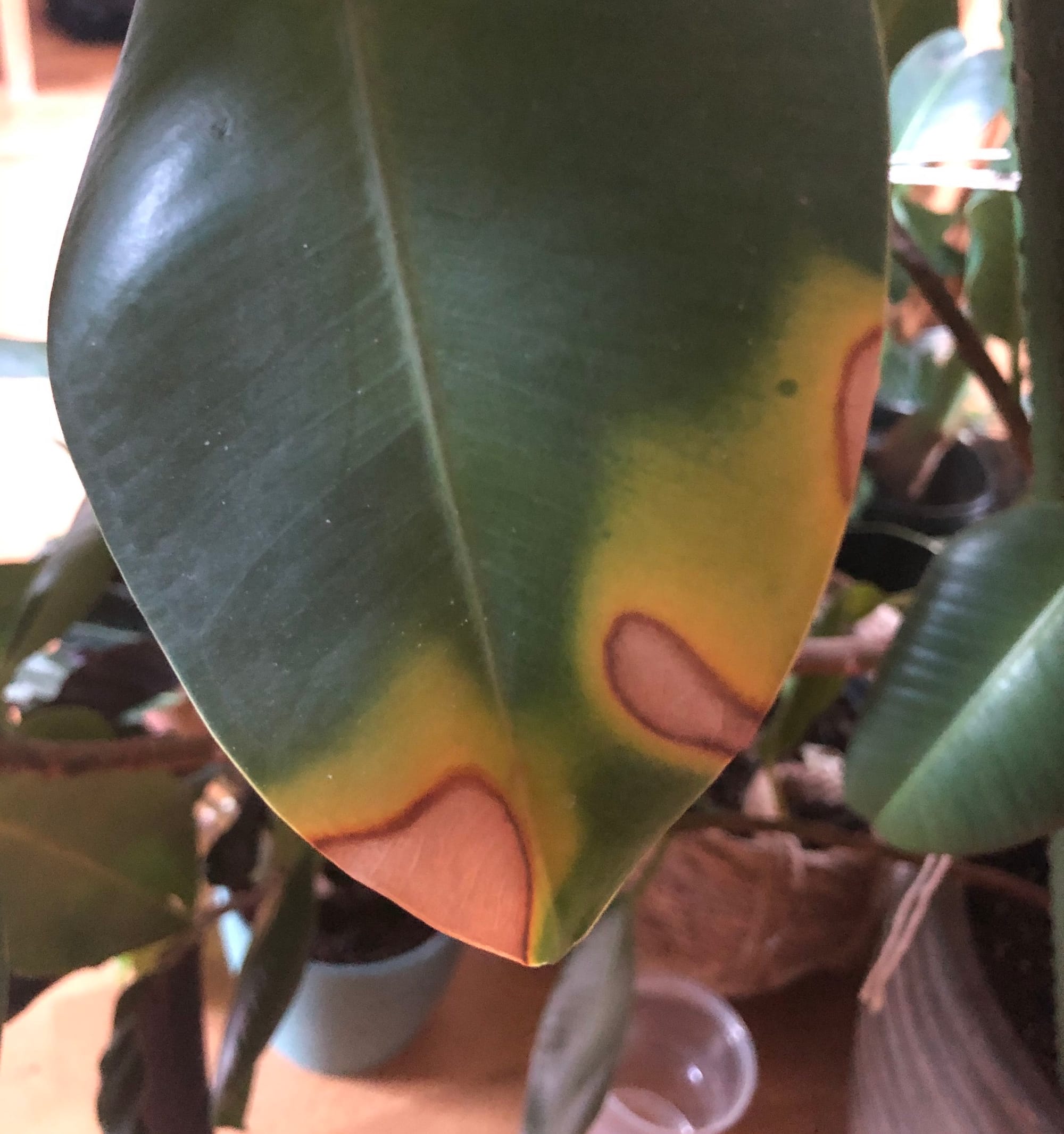 Example 1.
Example 1.
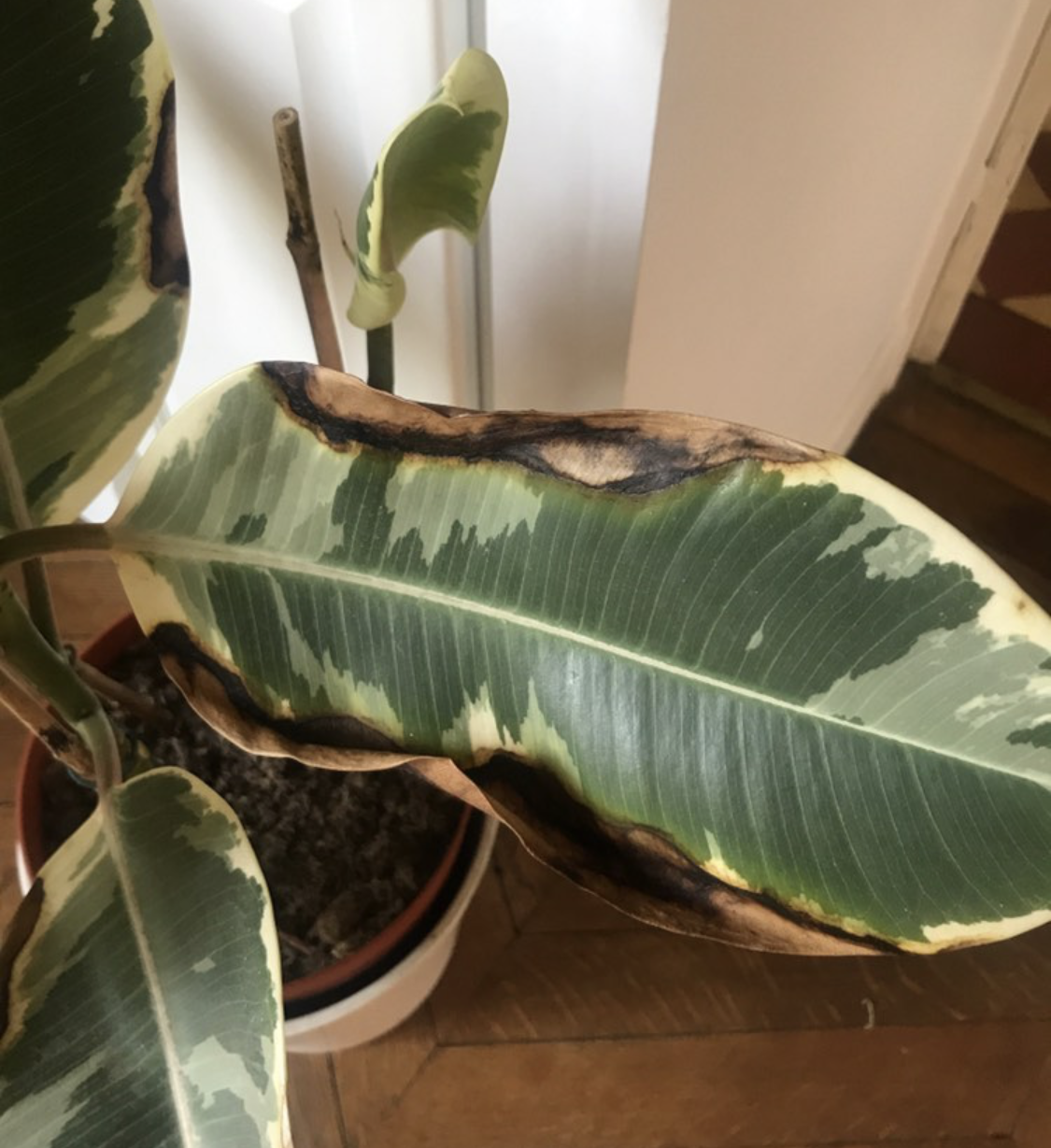 Example 2. Additionally, it's more common for variegated varieties to get browned leaf-edges due to the thinner leaf tissue on the white areas. Always use lukewarm water, and if you choose to use tap water, allow it to stand for at least 24hrs before application. This species tends to be quite sensitive to temperature change, so pouring cold tap water immediately into the pot will not only add fluoride into the soil, but it could even cause yellowed leaf-edges over time.
Example 2. Additionally, it's more common for variegated varieties to get browned leaf-edges due to the thinner leaf tissue on the white areas. Always use lukewarm water, and if you choose to use tap water, allow it to stand for at least 24hrs before application. This species tends to be quite sensitive to temperature change, so pouring cold tap water immediately into the pot will not only add fluoride into the soil, but it could even cause yellowed leaf-edges over time.
Curled leaves and brown leaf-edges are the result of too little water and over-exposure to the sun. Most Ficus are best located in bright, indirect settings, and those that haven't acclimatised to the harsh rays will show signs of sun-scorch and environmental shock. A splash of winter sunlight is acceptable as long as the soil moisture is regularly observed, with complete avoidance once summer comes along.
Never allow temperatures to dip below 12ºC (54ºF) as irreversible damage will occur in the likes of yellow foliage and weakened health. When this happens, remove the severely affected areas and immediately improve growing conditions - never cut through softened yellow growth, and only around brown, crispy squares. As rehabilitation can take several months because of its slow-growing nature, be sure to provide a stable location with better growing conditions to speed this process.
If your specimen is located in a dark environment, use a chopstick to gently stab the soil in various areas. You should aim to enter the compost between the base of the plant and the pot's edge, as failure to do so may lead to damaging its lower portion. Leave the holes open for a few days before re-surfacing the soil to avoid it becoming overly dry. Not only will the gentle shift in the soil's structure mimic the work of small invertebrates in the wild (worms, etc.), but it'll also add oxygen back into the soil, thus reducing the risk of root rot. Repeat this monthly, or whenever you feel the potting-mix isn't drying out quickly enough.
Origins
Ficus is a pantropical genus consisting of over 800 species, first described by Carl Linnaeus in 1753. Many species uniquely rely on a specific wasp, dubbed the Fig Wasp, to pollinate its flowers by laying eggs into the ostioles, a process that still baffles botanists today. Although the genus was formally recognized in the 18th century, it's believed that it was the first deliberately bred species for agriculture in the Middle East, more than 11,000 years ago. F. elastica was first described by William Roxburgh in 1814, before being reclassified nine years later by Danish botanist, Jens Wilken Hornemann, during a visit to south-east Asia. Its milky white sap was used for latex, which in turn enabled industrialists to fabricate rubber roughly two hundred years ago. F. robusta is synonymous to F. elastica.
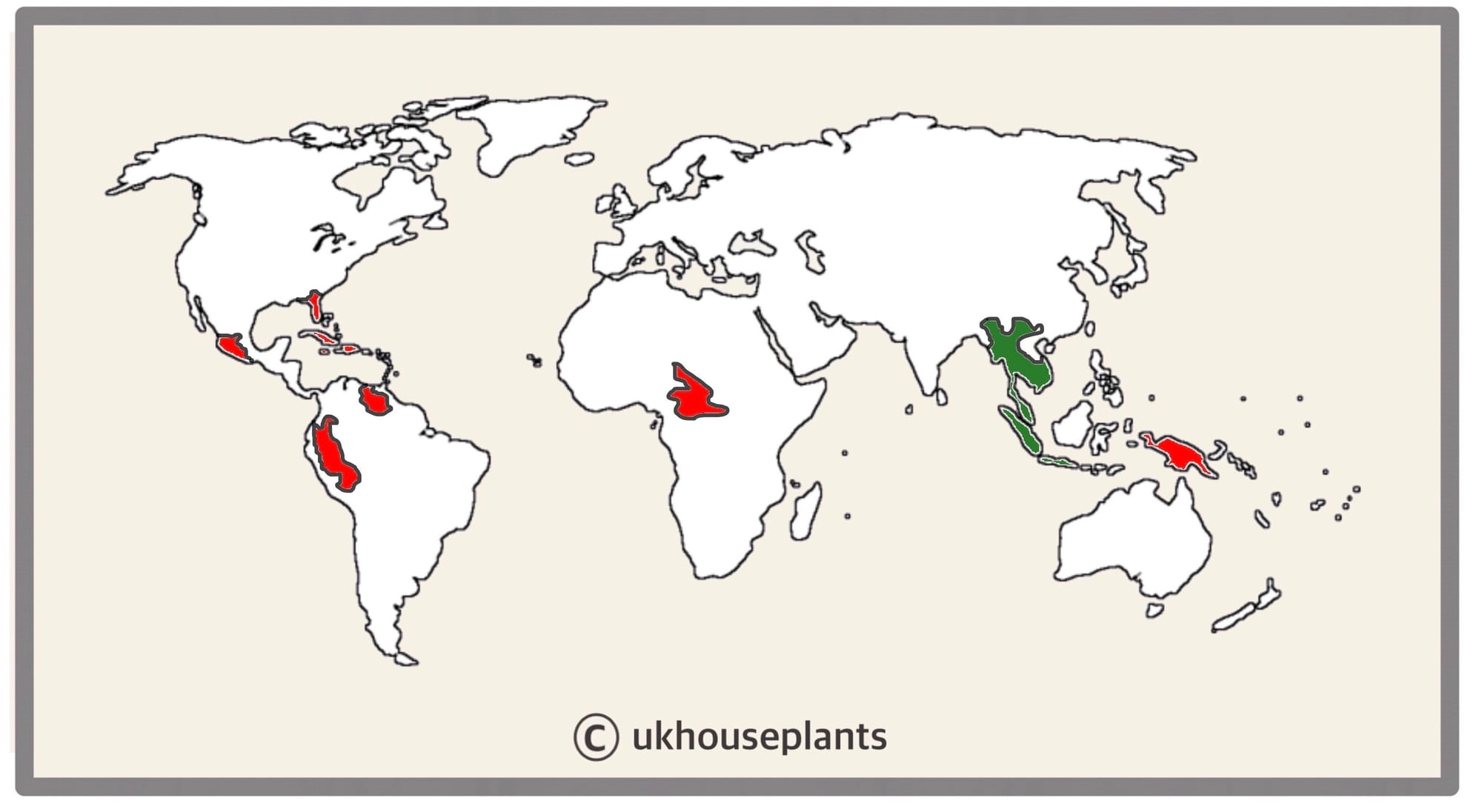 The Distribution of Ficus elastica
The Distribution of Ficus elastica
Temperature
12° - 26°C (54° - 80°F)
H1b (Hardiness Zone 12) - Can be grown outdoors during the summer in a sheltered location with temperatures above 12℃ (54℉), but is fine to remain indoors, too. If you decide to bring this plant outdoors, don't allow it to endure more than an hour of direct sunlight a day as it may result in sun-scorch and dehydration. Regularly keep an eye out for pests, especially when re-introducing it back indoors.
Pruning & Maintenance
Up to 4m in height and 1.5m in width. The ultimate height will take around 10 years to achieve, with 12cm of growth per season.
Pruning
Remove yellow or dying leaves, and plant debris to encourage better-growing conditions. While pruning, always use clean scissors or shears to reduce the chance of bacterial and fungal diseases. Never cut through yellowed tissue as this may cause further damage in the likes of diseases or bacterial infections. Remember to make clean incisions as too-damaged wounds may shock the plant, causing weakened growth and a decline in health.
Propagation
Via Seed or Stem Cuttings..
Stem & Eye Cuttings (Difficult) (Photo Below) - This method of propagation is troublesome without the aid of bottom-heat and a controlled environment. Choose the healthiest, most established stems that are wooded, yet still juvenile enough to bend slightly, being just thicker than a pencil. Each cutting should only have two leaves, and a small portion of the stem to either side of them. Cut directly below a node using a clean knife to reduce bacteria count. Situate the cutting into moist 'Houseplant' compost, with the only the leaf sticking out of the soil. 'Blackleg' can occur when the bottom wound becomes infected, resulting in propagation failure - typically caused by water-logging or a too-damaged wound. Maintain bright light and evenly moist soil with the avoidance of direct sunlight or cold draughts. Wrap the pot (& foliage) in a transparent bag or within a miniature greenhouse, and provide bottom hear of temperatures above 18°C (54°F). Remove the bag and place into individual 7cm (3 inches) pots once the second new leaf emerges. Follow the same care routines, as mentioned in the article's top half. This method will take up to five months, so patience and the correct environment are paramount for success!
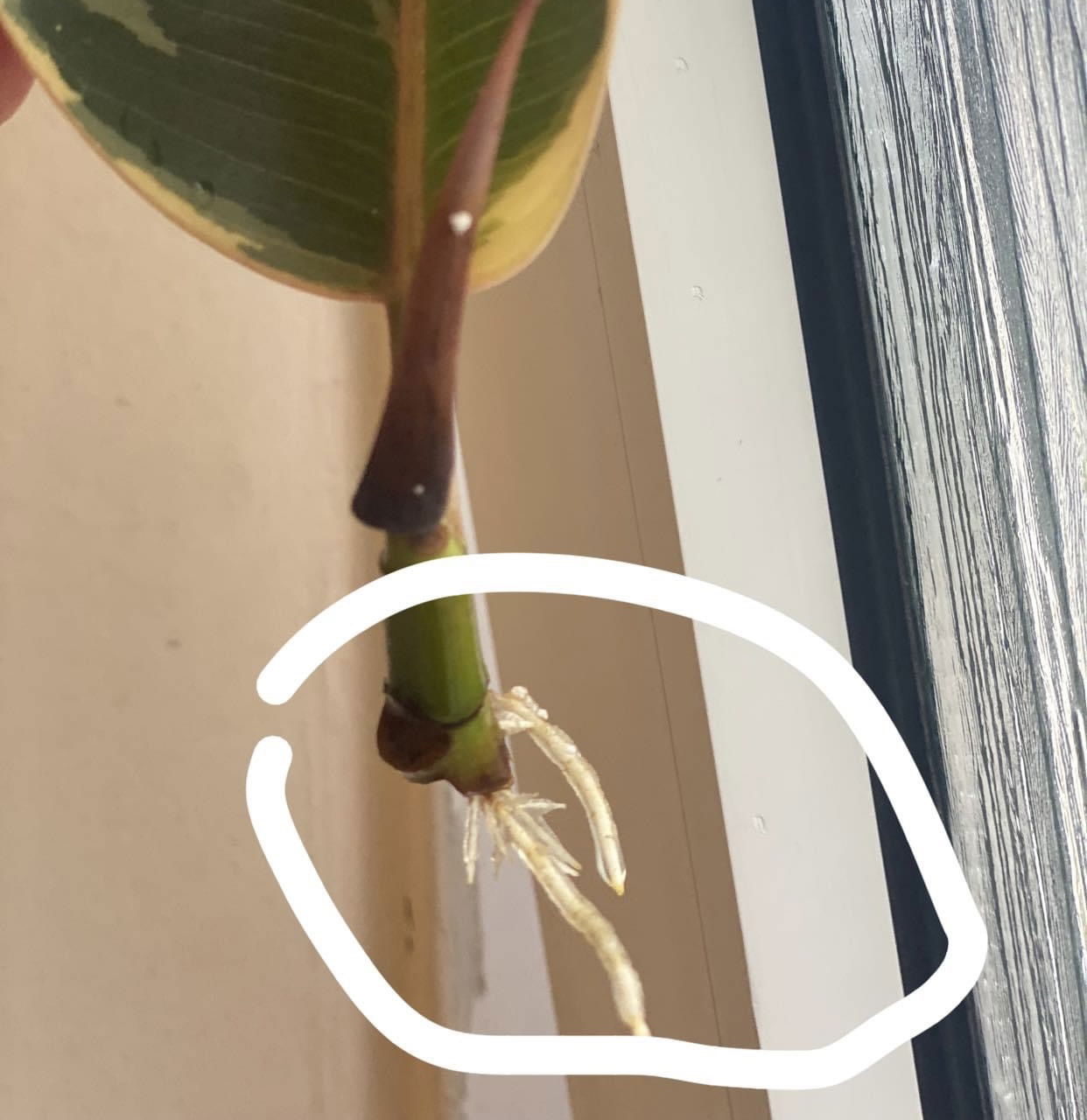 Although it's rather difficult, you can successfully root a Rubber Plant in water during the spring or summer months!
Although it's rather difficult, you can successfully root a Rubber Plant in water during the spring or summer months!
Flowers
Rubber Plant inflorescences consist of white flowers developing in early springtime that can vary in size. This period will last up to several weeks and will from berries if pollination is successful. Unfortunately, all Ficus are highly unlikely to flower if grown domestically, due to the incorrect environmental conditions found in a typical home.
Repotting
Repot every three years in the spring, using a 'Houseplant' labelled compost and the next sized pot with adequate drainage. Hydrate the plant 24hrs before tinkering with the roots to prevent the risk of transplant shock. For those that are situated in a darker location, add a thin layer of small grit in the pot's base to improve drainage and downplay over-watering. Click here for a detailed step-by-step guide on transplantation, or via this link to learn about repotting with root rot.
Book a 1-to-1 video call with THE HOUSEPLANT DOCTOR™ if you'd like a personal guide to repotting your houseplant. This will include recommending the right branded-compost and pot size, followed by a live video call whilst you transplant the specimen for step-by-step guidance and answer any further questions!
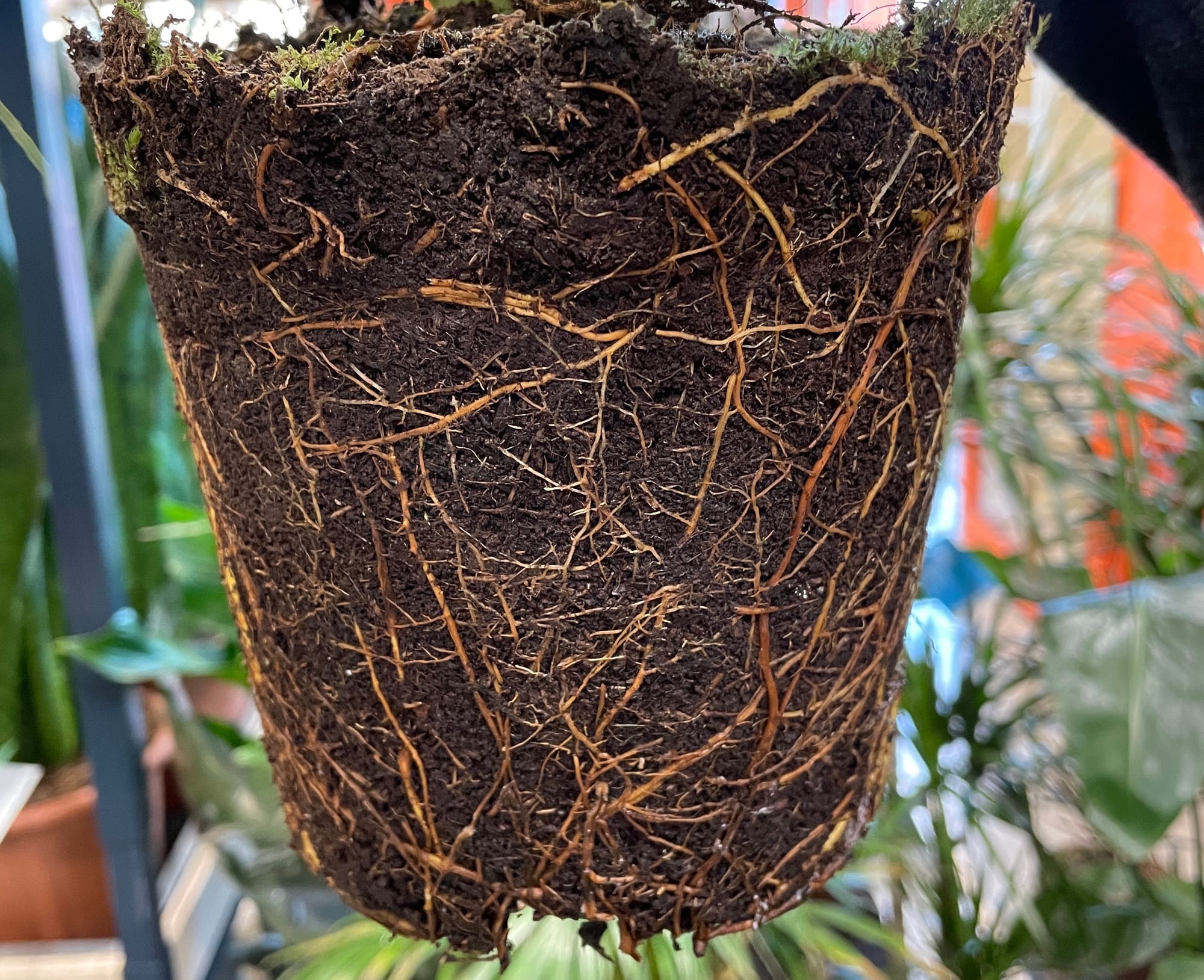 Here's an example of a Rubber Tree's healthy root system.
Here's an example of a Rubber Tree's healthy root system.
Pests & Diseases
Keep an eye out for mealybugs, aphids, spider mites, scale, thrips, whitefly & root mealybugs that'll locate themselves in the cubbyholes and undersides of the leaves, with the exception of the latter in the soil. Common diseases associated with Rubber Plants are root rot, leaf-spot disease, botrytis, rust, powdery mildew & southern blight - click here to learn more about these issues.
If the specimen has dry white crusty patches on its foliage or stem, this is its sap, commonly caused by damage via touch.
Toxicity
This plant is classified as poisonous; if parts of the plants are eaten, vomiting, nausea and a loss of appetite could occur. Consumption of large quantities must be dealt with quickly; acquire medical assistance for further information. The sap can also cause dermatitis and skin allergy to sensitive individuals, so be sure to wear gloves when handling.
 Rubber Trees have been commercially sold for the last century as pictured here! Circa 1950s-1960s. Credit Unknown.
Rubber Trees have been commercially sold for the last century as pictured here! Circa 1950s-1960s. Credit Unknown.
Retail Locations
B&Q, Blue Diamond, Dobbies & Online Stores.
Book a 1-to-1 Call with THE HOUSEPLANT DOCTOR™
If you need further advice with your houseplants, book an advice call with ukhouseplants' friendly and expert writer today! This can be done via a video or audio call on most apps, including Facebook, FaceTime & Skype. A ten-minute call costs £5.99 (US$7), or £15.99 for thirty minutes. You can ask multiple questions, including queries on plants, pests, terrariums, repotting advice and anything in between. Please consider supporting this service to keep ukhouseplants thriving!